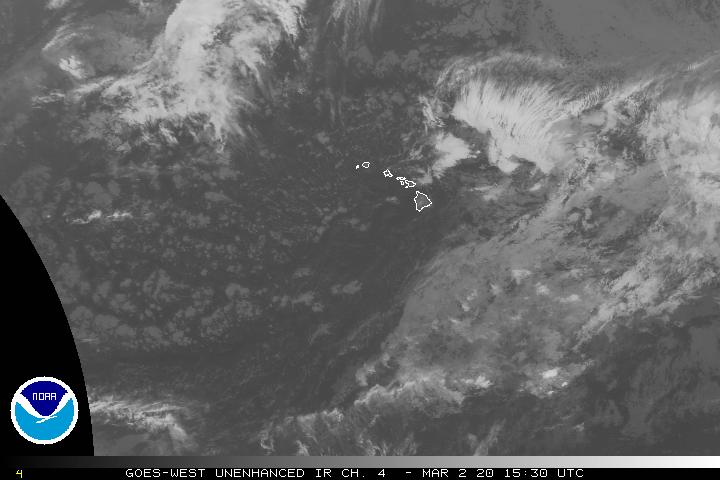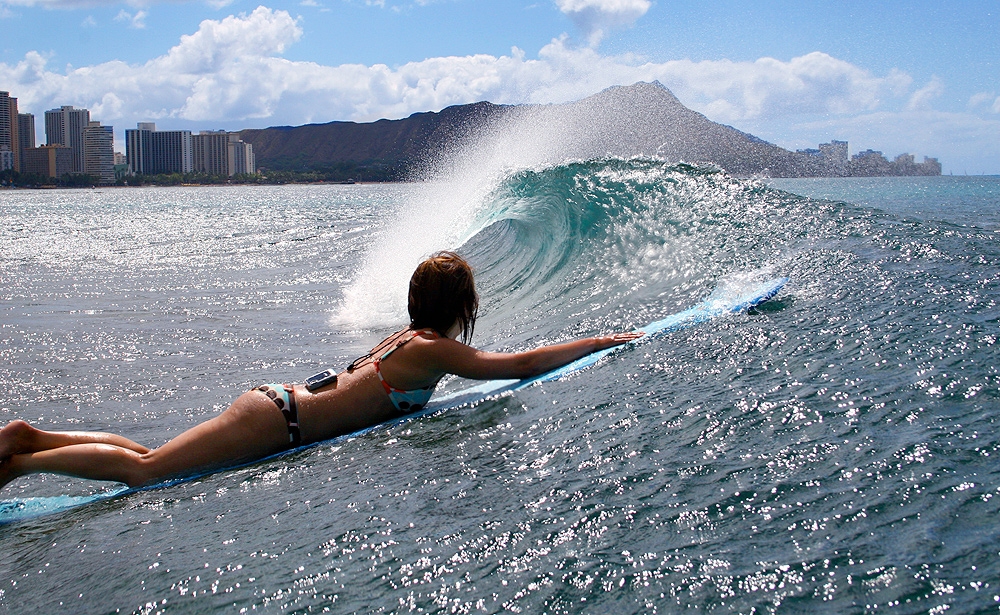Air Temperatures – The following maximum temperatures (F) were recorded across the state of Hawaii Tuesday…along with the minimums Tuesday:
81 – 72 Lihue, Kauai
86 – 73 Honolulu, Oahu
81 – 69 Molokai AP
83 – 69 Kahului AP, Maui
83 – 72 Kailua Kona
82 – 69 Hilo AP, Hawaii
Here are the latest 24-hour precipitation totals (inches) for each of the islands…as of Tuesday:
0.47 Mount Waialeale, Kauai
0.31 Waiawa, Oahu
0.35 Puu Alii, Molokai
0.00 Lanai
0.00 Kahoolawe
1.19 West Wailuaiki, Maui
2.32 Saddle Quarry, Big Island
The following numbers represent the strongest wind gusts (mph)…as of Tuesday:
31 Port Allen, Kauai
40 Oahu Forest NWR, Oahu
31 Molokai
35 Lanai
42 Kahoolawe
30 Kahului AP, Maui
35 Waikolola, Big Island
Hawaii’s Mountains – Here’s a link to the live web cam on the summit of near 13,800 foot Mauna Kea on the Big Island of Hawaii. This web cam is available during the daylight hours here in the islands…and when there’s a big moon shining down during the night at times. Plus, during the nights you will be able to see stars, and the sunrise and sunset too…depending upon weather conditions.
Aloha Paragraphs

Low pressure systems over the ocean far to the north…
along with their trailing cold fronts

Scattered clouds…thunderstorms far southwest through southeast

Clear to partly cloudy…some cloudy areas windward

Showers falling locally – looping radar image
Small Craft Advisory…all Hawaiian waters
High Surf Advisory…north and west shores of
Kauai, Oahu, Molokai, and north shore of Maui
~~~ Hawaii Weather Narrative ~~~
Trade winds continuing…moderate to locally strong and gusty. Here’s the latest weather map, showing the Hawaiian Islands, and the rest of the North Pacific Ocean. We find a near 1030 millibar high pressure system offshore to the northeast of the islands, moving eastward…with its trailing ridge of high pressure well north and northwest of the islands. At the same time, we see storm and gale low pressure systems well offshore northwest through northeast of the islands, along with their associated cold fronts. The trade winds will continue, blowing generally in the moderately strong realms…although locally stronger and gusty at times.
Here’s a wind profile…of the offshore waters around the islands – with a closer view
Here’s the Hawaiian Islands Sulfate Aerosol animated graphic – showing vog forecast
Showers restricted to the windward sides…although not exclusively. The trade winds will keep shower activity focused along the windward sides for the most part, although with a few stretching over into the leeward sides, carried by the gusty trades. This trade wind weather pattern will continue through the rest of this week at least. Cold fronts will pass by to our north…although some of the computer models are suggesting that we could see the tail-end of a front approaching by the weekend. If this forecast holds up over time, we could see some increase in showers for a day or two then. There may be a fair amount of instability in our atmosphere then as well, so some of these weekend showers may turn out to be quite generous.
Marine environment details: The current large northwest swell is expected to decline. A high surf advisory is in effect for most north and west facing shores. A small craft advisory /SCA / is also in effect for all coastal waters for the locally strong trade winds and seas.
A similar-sized northwest swell will likely bring high surf advisory conditions again to most north and west facing shores…Friday and Friday night.
Elsewhere, rough and choppy waves will continue through at least Thursday, due to the strong trades and the upstream wind fetch pointed towards Hawaii. No highlights are in effect now for the east shores, but surf heights could approach advisory conditions along east facing shores over the next couple of days until winds taper off Friday. The SCA will likely be scaled back early Wednesday morning as the northwest swell lowers. However some zones will remain in the SCA on Wednesday and Thursday due to winds.
A series of small south swells will continue throughout the forecast period.

Gusty trade winds…active surf north, west and east shores
World-wide tropical cyclone activity:
>>> Atlantic Ocean: The last regularly scheduled Tropical Weather Outlook of the 2015 Atlantic hurricane season…has occurred. Routine issuance of the Tropical Weather Outlook will resume on June 1, 2016. During the off-season, Special Tropical Weather Outlooks will be issued if conditions warrant. Here’s the 2015 hurricane season summary
Here’s a satellite image of the Atlantic Ocean
>>> Caribbean Sea: The last regularly scheduled Tropical Weather Outlook of the 2015 Atlantic hurricane season…has occurred. Routine issuance of the Tropical Weather Outlook will resume on June 1, 2016. During the off-season, Special Tropical Weather Outlooks will be issued if conditions warrant.
>>> Gulf of Mexico: The last regularly scheduled Tropical Weather Outlook of the 2015 Atlantic hurricane season…has occurred. Routine issuance of the Tropical Weather Outlook will resume on June 1, 2016. During the off-season, Special Tropical Weather Outlooks will be issued if conditions warrant.
Here’s a satellite image of the Caribbean Sea…and the Gulf of Mexico
Here’s the link to the National Hurricane Center (NHC)
>>> Eastern Pacific: The last regularly scheduled Tropical Weather Outlook of the 2015 North Pacific hurricane season…has occurred. Routine issuance of the Tropical Weather Outlook will resume on May 15, 2016. During the off-season, Special Tropical Weather Outlooks will be issued if conditions warrant. Here’s the 2015 hurricane season summary
Here’s a wide satellite image that covers the entire area between Mexico, out through the central Pacific…to the International Dateline.
Here’s the link to the National Hurricane Center (NHC)
>>> Central Pacific: The central north Pacific hurricane season has officially ended. Routine issuance of the tropical weather outlook will resume on June 1, 2016. During the off-season, special tropical weather outlooks will be issued if conditions warrant. Here’s the 2015 hurricane season summary
Here’s a link to the Central Pacific Hurricane Center (CPHC)
>>> South Pacific Ocean: No active tropical cyclones
>>> North and South Indian Oceans / Arabian Sea:
Tropical Cyclone 19S (Fantala) remains active in the South Indian Ocean…here’s the JTWC graphical track map, a satellite image, and what the computer forecast models are showing
Here’s a link to the Joint Typhoon Warning Center (JTWC)
Interesting: Supernova explosion impacted Earth within the last 9 million years – Two new papers appearing in the journal Nature this week are “slam-dunk” evidence that energies from supernovae have buffeted our planet, according to astrophysicist Adrian Melott of the University of Kansas.
Melott offers his judgment of these studies in an associated letter, entitled “Supernovae in the neighborhood,” also appearing this week in Nature.
One paper, authored by Anton Wallner and colleagues, proves the existence of ancient seabed deposits of iron-60 isotopes, tracing their source to supernovae occurring about 325 light years from Earth. The second paper, by a team headed by Deiter Breitschwerdt, estimates explosion times of these supernovae, isolating two events: one 1.7 to 3.2 million years ago, and the other 6.5 to 8.7 million years ago.
“This research essentially proves that certain events happened in the not-too-distant past,” said Melott, a KU professor of physics and astronomy. “They make it clear approximately when they happened and how far away they were. Knowing that, we can consider what the effect may have been with definite numbers. Then we can look for events in the history of the Earth that might be connected to them.”
Melott said both supernovae events were beyond the “kill zone” of roughly 30 light years, but they might have had other impacts — including influence on human evolution.
“Our local research group is working on figuring out what the effects were likely to have been,” he said. “We really don’t know. The events weren’t close enough to cause a big mass extinction or severe effects, but not so far away that we can ignore them either. We’re trying to decide if we should expect to have seen any effects on the ground on the Earth.”
Melott said Fields originally conceived of using iron-60 as a telltale isotope to expose historical episodes of neighborhood supernovae.
“In the 1990s he did the calculations and carried it forward,” stated Melott. “He said, ‘Hey, look for iron-60. This is a way to find out if there have been supernova near the Earth.’ Five years later came the first indications of supernovae using iron-60. Now, 20 years later, we’ve got a slam-dunk. So Fields is the one that really got all this going, and it’s just a really nice coincidence that’s he’s coming to KU just as these papers are coming out.”












 Email Glenn James:
Email Glenn James:
John Morey Says:
love your site. have been reading for years and try not to ask questions that may have been asked. But for the first time will be spending the coming week on the leeward side of Oahu and see both rain and the trades are a factor. But wondering….is the rain forecast more likely for windward Oahu and we are on the leeward side may not get much rain…and even see sun?
Thank you
~~~ Hi John, good to hear from you, and thanks for your nice and supportive words of encouragement.
Glad to hear that you will be visiting the leeward side of Oahu for a week, good choice!
As for the weather, I don’t see any major problems at all, with just a few showers now and then…mostly at night. The trade winds will be a little uppity at times, although nothing that will interrupt your fun.
So, please enjoy your time here in Paradise, on the lovely Gathering Place island of Oahu!
Aloha, Glenn